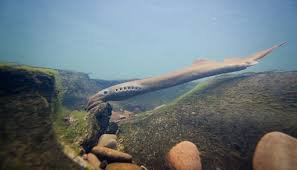Council Approves New Projects Under Pacific Lamprey Conservation Initiative
- January 22, 2019
- John Harrison

This month the Council approved funding for seven projects that focus on improving conditions for Pacific Lamprey, a fish species native to the Columbia River Basin that spawns in freshwater and spends a portion of its life cycle in the ocean. The species is culturally important to Columbia River Indian tribes, and its productivity has been diminished over time by the impacts of hydropower dams.
The seven projects are part of the Pacific Lamprey Conservation Initiative of the U.S. Fish and Wildlife Service, a comprehensive plan to conserve and restore the species throughout their range on the West Coast and Alaska in collaboration with tribes, federal, state, and local agencies and other entities.
Three Columbia River Basin projects were funded for about $248,000 under the Initiative in 2018, and the Council decided that the success of those projects supported continuing the effort in 2019 with the seven new projects with funding of about $238,000. Improving lamprey populations is identified as a critical emerging priority in the Council’s Columbia River Basin Fish and Wildlife Program.
In future years, funding of about $300,000 per year is anticipated. Funding for the projects, provided by the Bonneville Power Administration, comes from cost savings in other projects in the Council’s Fish and Wildlife Program, which Bonneville funds. As well, the projects are designed to be completed in one year so as not to create an ongoing funding obligation.
The 2019 actions, sponsors, and amounts are:
- Klickitat River passage improvements; Yakama Nation and Washington Department of Fish and Wildlife (WDFW); $25,000
- Reduce entrainment of larval and juvenile lamprey at dams in the upper Columbia River; U.S. Bureau of Reclamation (BOR), WDFW, Yakama Nation, U.S. Fish and Wildlife Service (USFWS), and Chelan County Public Utility District; $62,630
- Southwest Washington lower Columbia River lamprey assessment; WDFW and USFWS; $15,622
- Assessments of lamprey passage at fish hatchery fishways and barrier dams in the lower Columbia River; USFWS, Oregon Department of Fish and Wildlife (ODFW), WDFW, and private parties; $28,760
- Research best management practices for evaluating lamprey passage at culverts; Stillwater Sciences, USFWS, and the Lamprey Technical Workgroup; $15,000
- Improve the counting of adult lamprey in the McKenzie River, a Willamette River tributary; ODFW, U.S. Army Corps of Engineers, and Eugene Water and Electric Board; $27,500
- Improve dam passage of juvenile lamprey in the lower Yakima River and Columbia rivers; U.S. Geological Survey, BOR, Yakama Nation, and irrigation districts; $37,292.
The Pacific Lamprey Conservation Initiative is a three-part process that takes a landscape approach to improving populations of the species. The first part was developing an assessment and template of conservation measures, completed in October 2011. The second part was developing a conservation agreement among the parties. That was completed in June 2012. The third part is developing regional implementation plans, like the one for the Columbia River Basin. The lamprey projects recommended by the Council in 2018 and this month are consistent with the conservation agreement.
Pacific Lamprey have been addressed in the Council’s Fish and Wildlife Program since 1994, beginning with a project to research and restore lamprey populations on ceded lands of the Confederated Tribes of the Umatilla Indian Reservation. Over time, four other lamprey restoration plans were developed, resulting in other lamprey projects in the Council’s Program. Today, there are six Pacific Lamprey projects in the Program.



